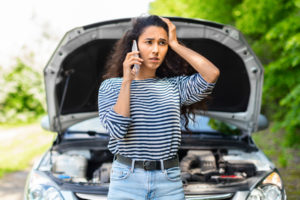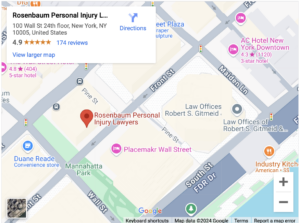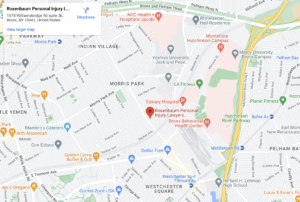What If the Other Driver Doesn’t Have Insurance?

A nightmare scenario for anyone who drives or rides in a car is to suffer serious injuries in a car accident caused by an uninsured driver. Of course, New York’s no-fault system will take care of you up to certain limits, no matter whose fault the accident was. However, if your liability is much greater than the insurance policy limits, you might be in trouble. Following are some tips on preparing for and dealing with such a situation.
Table of Contents
New York No-Fault Insurance System

Under New York’s no-fault auto insurance system, you must look first to your own personal injury protection (PIP) insurance for compensation, regardless of who was at fault for the accident. Your PIP policy will pay even if the accident was 100% your fault. It also covers injuries to your passengers, bicyclists, and pedestrians. Significantly, no-fault insurance does not cover motorcyclists.
You can recover economic damages (mainly medical expenses and lost earnings), but you cannot recover for pain and suffering or other non-economic damages. To recover non-economic damages, you must qualify to exit New York’s no-fault system before you can sue anyone. To qualify, you must have suffered a serious injury, as New York law defines “serious,” or you must have suffered more than $50,000 in economic damages.
What Is a “Serious” Injury Under New York’s No-Fault Law?
Under Article 5102 of the New York State Insurance Law, your injury is “serious” if you suffer:
- Death (giving the personal representative of your estate a wrongful death claim);
- Dismemberment;
- Significant disfigurement;
- Loss of a fetus;
- A fractured bone;
- Permanent loss of an organ of your body (an eye, for example);
- Permanent loss of a limb or a bodily function or system;
- A significant limitation of the use of your body; or
- A disability lasting at least 90 days that prevents you from performing virtually all of your usual daily activities that occurs during the six months following your injury.
The preceding disabilities are vaguely defined enough to leave room for argument about whether they apply to your case. This is another reason why you need a lawyer if you suspect your injuries might qualify as “serious.”
New York’s Mandatory Minimum Insurance
New York law requires every driver with a vehicle registered in the state to purchase the following minimum amount of auto insurance:
- $25,000 per person in personal injury liability insurance;
- $50,000 per accident in personal injury liability insurance;
- $10,000 in property damage liability insurance;
- $50,000 in personal injury protection (PIP) coverage;
- $25,000 per person in personal injury uninsured motorist insurance; and
- $50,000 per accident in personal injury liability uninsured motorist insurance.
“Per accident” insurance is shared among all claimants on your policy (your passengers, for instance). Only about 4% of New York drivers are uninsured, one of the lowest rates in the nation.
Collision Insurance
Your collision insurance, if you have any, can pay for damage to your vehicle. New York does not require its drivers to carry collision insurance. Keep in mind that collision insurance will not pay for medical expenses or any form of liability.
Uninsured Motorist Coverage
All New York motorists must purchase uninsured motorist insurance (see above). This extra $25,000 to $50,000, on top of your PIP insurance, may or may not be enough to provide you with total compensation. Even if not, it will help. Uninsured motorist insurance will pay if the other driver is uninsured or if you suffer a hit-and-run accident and cannot locate the at-fault driver.
Suing the At-Fault Driver
As a last resort, you might try suing the at-fault driver seeking satisfaction of your claim out of the driver’s personal assets. The problem, however, lies here—even if you qualify to exit New York’s no-fault system, most people without insurance can’t afford it, and people who can’t afford insurance can’t afford to pay a claim.
Even if you win a judgment against the at-fault driver’s personal assets, you might find yourself unable to collect your judgment. On the other hand, you might get lucky and discover that the driver is wealthy but simply forgot to renew their insurance.
Finding a Second Defendant
If none of the above options will work, a seasoned lawyer might be able to find a second defendant who is liable for the accident. Following are some examples of situations that might allow you to seek compensation from a second defendant:
On-Duty Employees
If the driver was an on-duty employee acting within the scope of their duties at the time of the accident, you could sue the driver’s employer. Businesses are typically well-insured for this type of liability.
DUI Accidents
You might have a claim against an alcohol vendor under New York’s dram shop law. Suppose a nightclub sold alcohol to the driver after they were visibly intoxicated. In that case, you could win damages if there was a causal relationship between the driver’s intoxication and your DUI accident.
Product liability
Product liability might apply if a defective product was at least partly responsible for your accident. You might sue the manufacturer of a malfunctioning traffic light, for example.
Suing the Government
If the government was to blame for a malfunctioning traffic light, you might be able to file a lawsuit against the appropriate government department. Beware—special restrictive rules apply to suing the government, including very short deadlines.
A Second At-Fault Driver
If another driver (excluding you and the uninsured driver) shared fault for the accident, you could seek partial damages from them under New York’s “pure comparative fault” compensation system. The second driver would bear liability in exact proportion to their percentage of fault as determined by a court.
An experienced personal injury lawyer can prove very useful in situations where you need to find a second defendant.
Special Case: The Other Driver Was Uninsured, But the Car Was Insured By Its Owner
Usually, insurance runs with the car, not the driver. Unless an exception applies, once you qualify to exit New York’s no-fault compensation system, you can file a third-party claim against the insurance policy covering the car. In other words, you probably don’t have an uninsured driver problem under this circumstance. Under the following scenario, however, you cannot file a claim against the insurance policy that covers the car:
- The at-fault driver did not have permission to drive the car; or
- The insurance policy in question excluded the at-fault driver from coverage
Ultimately, you need to look closely at the car owner’s insurance policy to ensure it applies in this situation.
Special Case: The At-Fault Driver is From Another State
Even if the at-fault driver is from out of state, as long as their insurance company has registered their business in New York, you do not have an “uninsured driver” problem. That is because New York requires auto insurance companies registered in-state to pay out New York’s mandatory minimum auto insurance compensation, even if the at-fault driver is from a state with lower mandatory minimum coverage.
If the at-fault driver’s insurance company is not registered in New York, you have an uninsured driver problem.
Contact a Car Accident Lawyer ASAP
Suffering an accident with an uninsured motorist can raise difficult and complex legal questions. You don’t need to face it alone, however. Contact a Rosenbaum Personal Injury Lawyers lawyer for a free initial consultation at (212) 514-5007. We enjoy over 40 years of experience, and we have won tens of millions of dollars for our clients.



